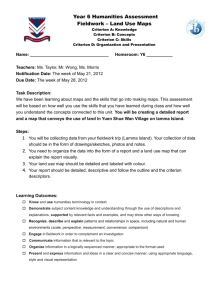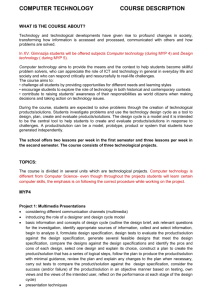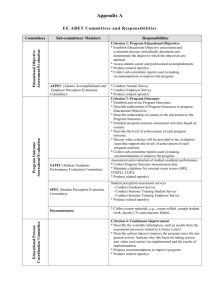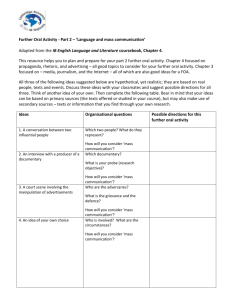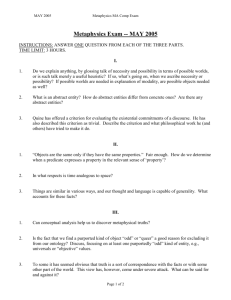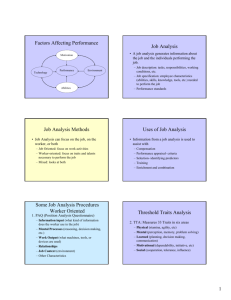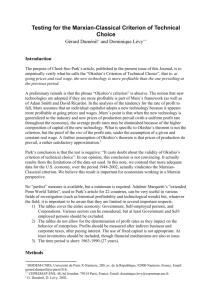Criteria (Evaluative standards) Criterion issues have major
advertisement
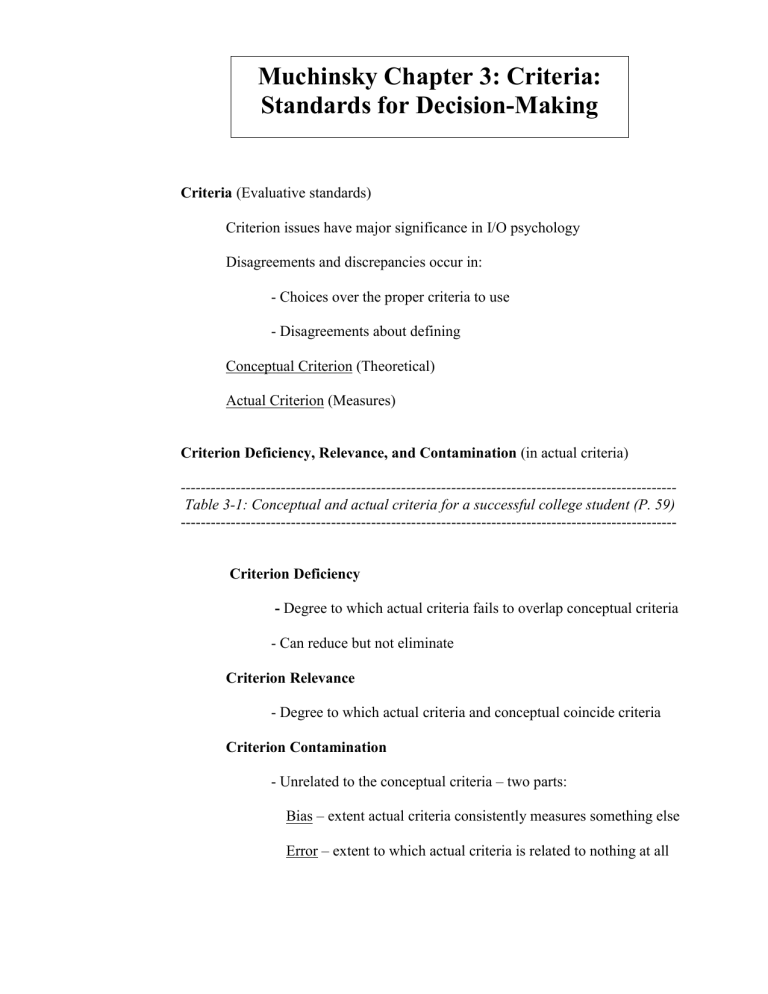
Muchinsky Chapter 3: Criteria: Standards for Decision-Making Criteria (Evaluative standards) Criterion issues have major significance in I/O psychology Disagreements and discrepancies occur in: - Choices over the proper criteria to use - Disagreements about defining Conceptual Criterion (Theoretical) Actual Criterion (Measures) Criterion Deficiency, Relevance, and Contamination (in actual criteria) --------------------------------------------------------------------------------------------------Table 3-1: Conceptual and actual criteria for a successful college student (P. 59) --------------------------------------------------------------------------------------------------- Criterion Deficiency - Degree to which actual criteria fails to overlap conceptual criteria - Can reduce but not eliminate Criterion Relevance - Degree to which actual criteria and conceptual coincide criteria Criterion Contamination - Unrelated to the conceptual criteria – two parts: Bias – extent actual criteria consistently measures something else Error – extent to which actual criteria is related to nothing at all - Both distort the conceptual criterion - Can be controlled statistically to some degree Job Analysis – (A main criterion definition task in I/O Psychology)) Procedure is to identify criteria in job performance by documenting: - Tasks - Situations - Human attributes needed Three major Sources of Job Information - Each is a SME( Subject Matter Expert) - Two are best sources of job information 1.) Job incumbent 2.) Supervisor - One is the best qualified to comprehend relationships among jobs 3.) (Trained) Job Analyst - All provide descriptive data Job Analysis Procedures (Three types) ---------------------------------------------------------------------------------------------Figure 3-2: Relationship among tasks, positions, jobs, and job families (P. 62) --------------------------------------------------------------------------------------------- Task – basic units of work - Position – units of work directed at specific job objectives - Job – aggregate of similar positions - Job Family – aggregate of similar jobs a. Task-Oriented Procedures Task Statements Series of specific statements Discrete unit of work (what is accomplished) Incumbents then rate the tasks (Example in Table 3-2) b. Worker-Oriented Procedures - Examines human attributes K – knowledge – types of information needed S – skills – proficiencies need that can be practiced A – abilities – relatively enduring innate proficiencies O – other – personality or capacities ------------------------------------------------------------------------------------------------Table3- 3: Importance scale for rating KSAO’s for electrician tasks (P. 66) ------------------------------------------------------------------------------------------------How to Collect Job Analysis Information Procedures for Collecting Information (Three procedures are followed) a. Interview (of SME’s) Can magnify the importance of their tasks b. Direct observation (of employees) Identifies adverse conditions; but not why of behaviors (See Field Note 1) ---------------------------------------------------------------------------------Field Note 1: A Memorable Lesson (P. 67) ----------------------------------------------------------------------------------------------------------------------------------------------------------------Field Note 2: Unintentional Obstruction of work (P. 68) --------------------------------------------------------------------------------c. Questionnaires/inventories (commercially available) Provide Taxonomic Information: Three examples 1.) Position Analysis Questionnaire (PAQ) - Compares job to an existing data base of jobs - This method is deductive, not inductive - Examines relationships among a set of jobs --------------------------------------------------------------------Figure 3-4: Sample items from the PAQ (P. 69) --------------------------------------------------------------------3.) O*NET (U.S. Dept. of Labor) - based on thousands of jobs - series of instruments to assess skills and interests - labor market information - multiple levels of analysis - multiple applications ---------------------------------------------------------------------------------Figure 3-5: Content Model of the O*NET (P. 70) --------------------------------------------------------------------------------Figure 3-6: Levels of information analysis in O*NET (P. 71) --------------------------------------------------------------------------------Managerial Job Analysis - Managerial work is less directly observable - Two instruments to analyze these jobs Professional and Managerial Position Questionnaire Personality-Related Position Requirements Form - Level of precision not as high as blue collar and clerical Uses of Job Analysis Information Offers rationale for personnel selection tests Organizes positions into job families to find compensation levels Provides information as to content of training needed Provides basis for content of performance appraisal Can be used in vocational counseling – career selection (O*NET) Can help with ADA criteria for reasonable accommodation Job Evaluation Procedure to determine relative value of jobs in an organization This helps determine level of pay for each job Also helps determine a fair and equitable wage structure How is this done? Two processes; determine: External equity The wage survey method is most common (going rate) Internal equity Determine fairness inside the organization ---------------------------------------------------------------------------------Cross-Cultural I/O Psychology: Wage rates around the world --------------------------------------------------------------------------------Method of Job Evaluation -----------------------------------------------------------------------------------------Table 3-4: Factor description table for Factor Evaluation System (P. 77) ------------------------------------------------------------------------------------------Factor Evaluation System (FES) - Used to evaluate government jobs; U.S. Civil Service - All jobs evaluated on Nine factors; low, medium, high - Assigned point value sets salary Job Performance Criteria Are defined by three criteria: Appropriate, Stable, Practical Must be relevant and representative of the job Should not be expensive or hard to measure No single universal best method exists There are, however, some conventional standards: Eight Major Criteria Some objective and some subjective At this end are typically very objective 1. Production Statistical procedures to equalize across jobs 2. Sales Norm Groups 3. Tenure or Turnover Voluntariness Functionality 4.Absenteeism 5. Accidents 6. Theft (Advances in decision-making about theft) ------------------------------------------------------------------------------------Figure 3-7: Incentive award method for reporting employee theft (P. 81) -----------------------------------------------------------------------------------------Those that are very subjective: 7. Counterproductive Workplace Behavior - Intentionality is assumed 8. Customer Service Behavior – three elements are: - Intangibility (impressions of others) - Simultaneity (involves other criteria) - Co-production (is influenced by the customer) ---------------------------------------------------------------------------------------Field Note 3:Theft of waste (P. 82) ---------------------------------------------------------------------------------------------------------------------------------------------------------------------------------The Changing Nature of Work: The New Recipe For Success (p.83) --------------------------------------------------------------------------------------------- Relationships between Job Performance Criteria Most are relatively independent from each other Research shows there really is no ‘one best’ ------------------------------------------------------------------------------------Table 3-5: Correlations among five criterion variables (P. 84) ------------------------------------------------------------------------------------- ------------------------------------------------------------------------------------------------Figure 3-8: Performance variation in three criteria over an eight-year period (P. 86) ------------------------------------------------------------------------------------------------Expanding Our View of Criteria From job related to good soldier - Pro-social behavior Contributions to organizational welfare Case Study: Theft of Company Property (P. 87) Chapter Summary (P. 88)

